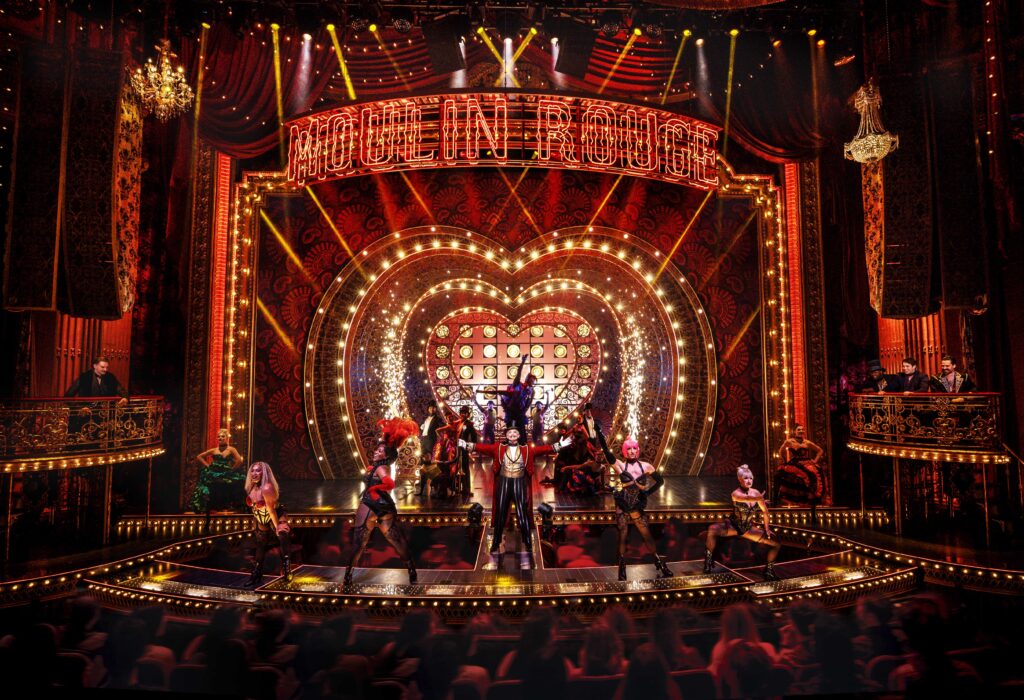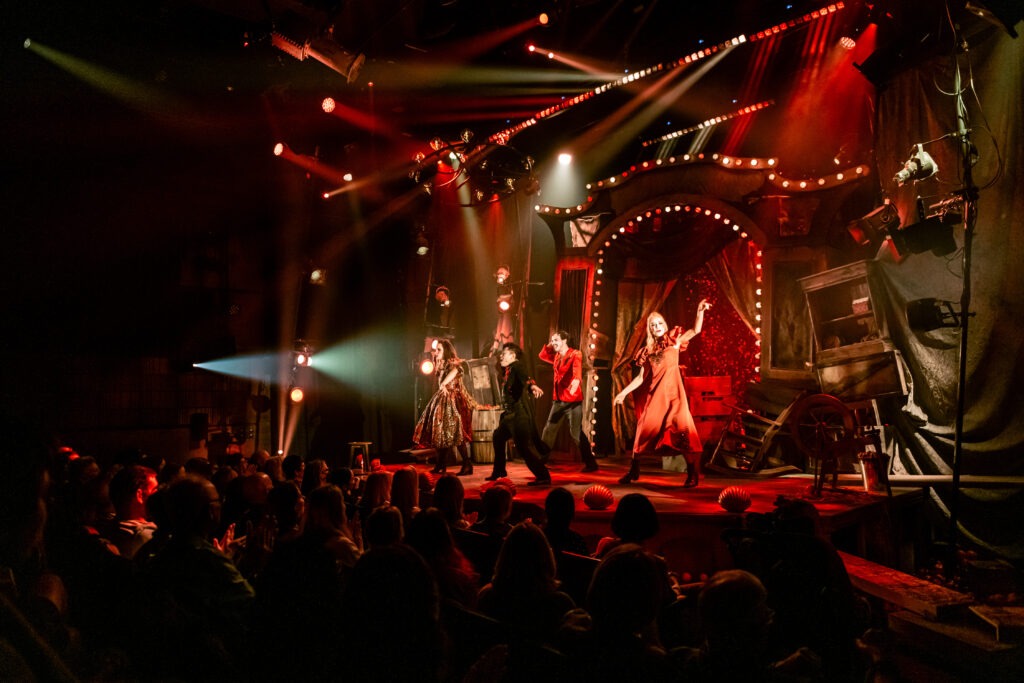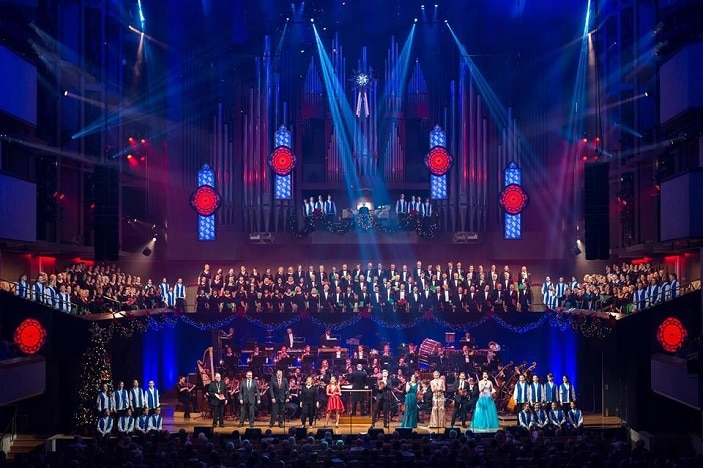
‘Moulin Rouge! The Musical’ // Global Creatures and Bill Damaschke
‘Moulin Rouge! The Musical’ was grandiose.
Kaleidoscopic, lavish, and bursting with colour and sound, ‘Moulin Rouge! The Musical’ opened QPAC’s Lyric Theatre with the energy of a Bohemian after-party – dazzling audiences with its stunning scenery from the moment the doors opened.
There was delighted laughter throughout, frequent applause, and a standing ovation – punctuated by the surprise appearance of ‘Moulin Rouge’ film creator Baz Luhrmann. The Aussie storyteller was introduced by producer Carmen Pavlovic, beaming with pride representing the first Australian company (Global Creatures) to originate a Broadway musical.
But as the story goes: “First, there is desire…”
It’s no surprise Best Scenic, Costume and Lighting Design are among the 10 Tony Awards the production has earned since opening on Broadway in 2019. These technical elements were integral in telling the story of talented composer Christian, who falls in love with Satine, the star of the Moulin Rouge club, where they meet in Paris at the turn of the century.
The crowd was immediately drawn in by the red mill (English translation of “moulin rouge” from French), standing in its own box on one side of the stage, with panels slowly turning as if real. On the other side sat the Blue Elephant, weighing 220kg, measuring 5.1 metres tall and made in honour of the original statue in the famous nightclub. Fifteen chandeliers hung from the ceiling; nine types of red fabric draped the theatre’s walls, and the layers of heart-shaped backdrops inspired by the film acted as portals that added depth; the attention to detail from Scenic Designer Derek McLane was beyond impressive and fully immersed the crowd into the French cabaret, building anticipation for the production to begin.
Costumes by Catherine Zuber did not disappoint. The vivacious women of the Moulin Rouge opened the night shimmering in red and black corset-style bodices and elaborate feather headpieces; the Can Can skirts popped in the traditional bright rainbow of colours and the men’s black suits with top hats and white vests completed the look of 1899, Paris. The lead performers’ costume changes were on-stage and seamless; the ‘Elephant Love Medley’ Act I finale, in particular, must be seen to be believed.
Lighting Designer Justin Townsend alternated between reds and blues, dipping into the green of absinthe and startling us with the stark white spotlights of ‘El Tango de Roxanne.’ But the central piece, the Moulin Rouge club, was realised “as if the audience were inside of a spinning crystal chandelier,” he wrote in the program. “I’ve tucked tiny, moving lights all around the theatre to allow the entire stage and house to animate and sparkle.” The effect was mesmerising and totally unique.
“…then passion…”
Choreographer Sonya Tayeh called the dancing “aggressively energetic” and “highly physical” – but even those strong terms may be an understatement. The four “ladies” Marmalade who opened the show were brimming with energy and committed to their characters’ individual styles. Samantha Dodemaide as Nini, Olivia Vasquez as Arabia, Chaska Halliday as La Chocolat and Christopher J Scalzo as Babydoll seemed to be operating at maximum volume – equally in vocals and movement. It was refreshing to see diversity reflected in these four, as well as the wider ensemble, and their energy was contagious.
Equally passionate were performances by Simon Burke AO as Harold Zidler, Ryan Gonzalez as Santiago, and Jarrod Draper as Toulouse-Lautrec. Seasoned professional Burke commanded the stage– and the audience—with ease and charisma, earning cheers whenever asked and laughs on almost every line. Gonzalez’ sex-crazed Armenian added to the comedy and exuded raw physical energy. Draper was a delightful surprise; his vocals were beautiful and his earnest commitment to the French artist was commendable – including an accent that never wavered.
Sound Designer Peter Hylenski, another Tony Award winner, explains in the program there are 200 speakers concealed in and around the set. He said he wanted the sound “to convey the unbridled explosion of a concert at moments, then throttle back to the intimacy of dialogue” – and he delivered on this goal expertly. Every word was heard; every finger snap and bass note punctuated the song and dance. The audio-visual assault of Act I contrasted beautifully with the pared-down, quieter moments of Act II. The sound was a huge part of the production’s success in a way that was obvious, even to those of us without an audio engineering degree.
“…then suspicion…”
While many young theatregoers will have no film version to compare their experience to, those who love the source material are right to be suspicious of changes. A newly presented love triangle and a re-imagining of the villain were two aspects that worked well. James Bryers’ Duke was unrecognisable from the fair-haired weasel of the movie. His new musical numbers, particularly the Rolling Stones mash-up, allowed Bryers a much darker, sexier persona than The Duke of 2001. He was scary but charismatic, evil but not quite repulsive.
Alinta Chidzey as Satine was extremely different from Nicole Kidman’s original portrayal. She belted the final line of ‘Diamonds’, whereas Kidman had been breathless; her Satine seemed to be a modern-day, stadium-style Beyonce for most of the show, whereas Kidman’s performance appeared timeless and intimate. This was perhaps intentional by both Chidzey and director Alex Timbers (who is quoted as wanting the music to feel “of the moment”). But it may be hard to reconcile for fans of the original.
“…then betrayal.”
When considering the original soundtrack, the man responsible for music supervision, orchestrations, arrangements, and additional lyrics sums it up well: “Every choice we make will piss off as many people as it delights,” Justin Levine wrote.
Of the additional musical numbers, about half delighted this fan of the original soundtrack, including the absolute standout dance number featuring ‘Bad Romance’ that opened Act II, and the mash-up including ‘Royals’ sung by Christian, Toulouse-Lautrec and Santiago.
However, it would be remiss to ignore the way younger audience members lit up with the remix of Sia’s ‘Chandelier’ or Gnarls Barkley’s ‘Crazy’. So while the additional songs felt like a betrayal from the original at times, there’s no denying Levine and music producer Matt Stine accomplished a unique celebration of popular music using over 70 songs—something for everyone, no doubt.
Truth, beauty, freedom, love
Last but far from least: Des Flanagan as utterly love-struck Christian. The audience didn’t need the blue spotlight to draw our eyes to his entrance; from the moment he appeared, his earnest smile was infectious. His vocals near-flawless with a buttery-smooth quality, Flanagan was generous in sharing the stage, his harmonies well-balanced and his performance natural.
His character believed so genuinely in those four Bohemian values – truth, beauty, freedom, love – and Flanagan’s storytelling and musical talent drew the crowd into his world.
If you want to be transported into the glitziest, most outrageous nightclub in Brisbane so you can sing along to the catchiest songs of the last 50 years, buy your tickets to ‘Moulin Rouge! The Musical’ – if you still “CAN CAN CAN…”
‘Moulin Rouge! The Musical’ performs until Thursday, 27 July 2023 at QPAC’s Lyric Theatre. For more information visit the QPAC website.






